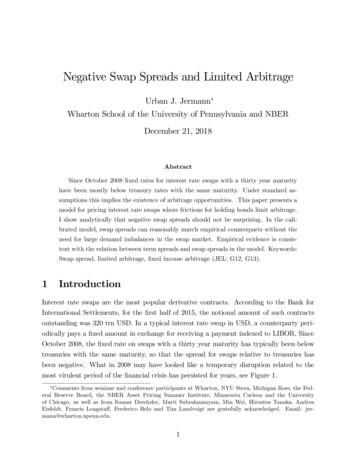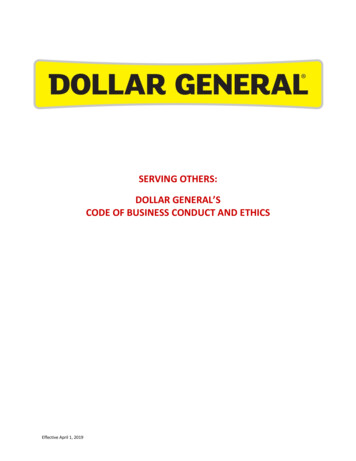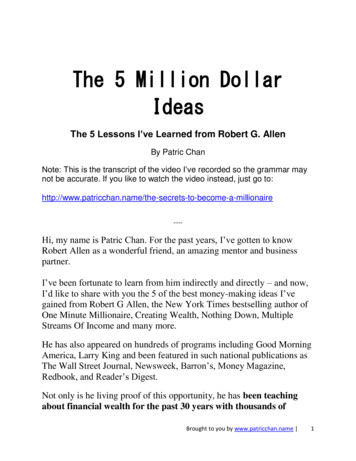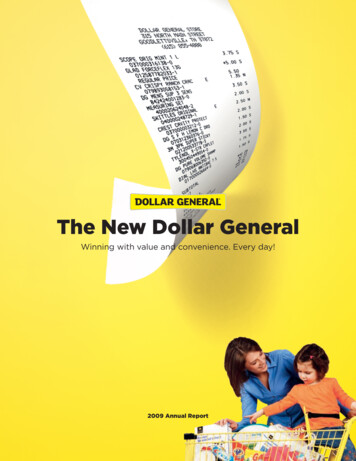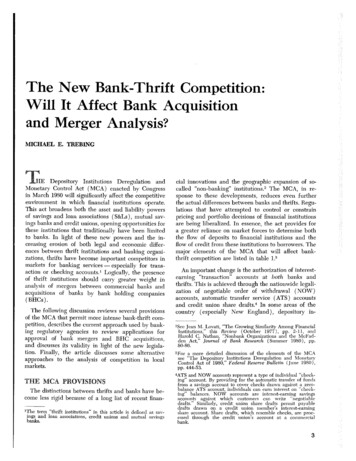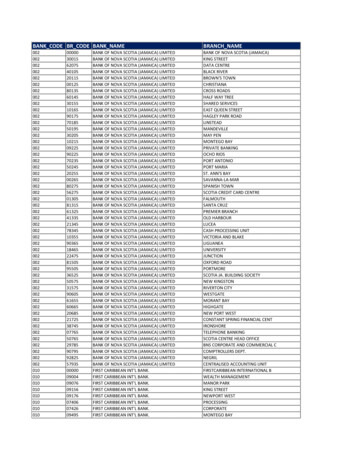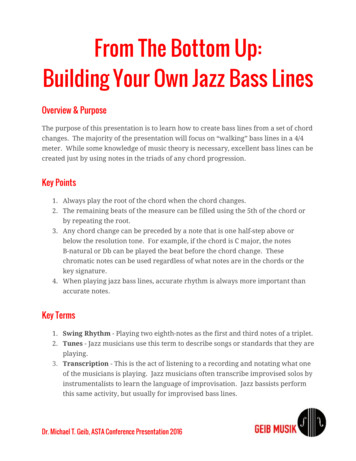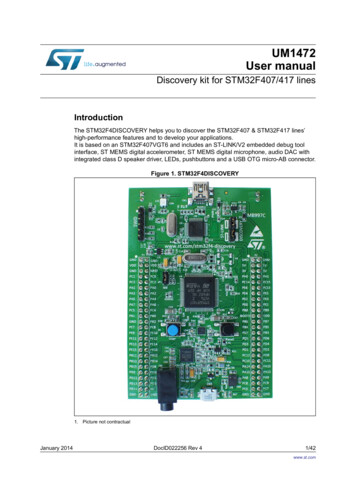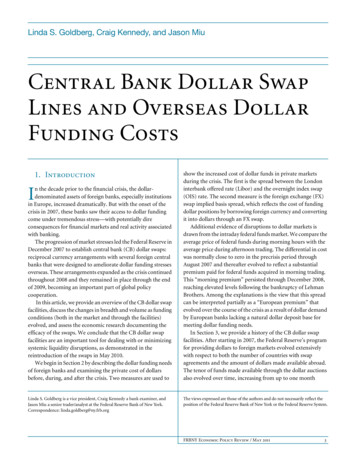
Transcription
Linda S. Goldberg, Craig Kennedy, and Jason MiuCentral Bank Dollar SwapLines and Overseas DollarFunding Costs1. IntroductionIn the decade prior to the financial crisis, the dollardenominated assets of foreign banks, especially institutionsin Europe, increased dramatically. But with the onset of thecrisis in 2007, these banks saw their access to dollar fundingcome under tremendous stress—with potentially direconsequences for financial markets and real activity associatedwith banking.The progression of market stresses led the Federal Reserve inDecember 2007 to establish central bank (CB) dollar swaps:reciprocal currency arrangements with several foreign centralbanks that were designed to ameliorate dollar funding stressesoverseas. These arrangements expanded as the crisis continuedthroughout 2008 and they remained in place through the endof 2009, becoming an important part of global policycooperation.In this article, we provide an overview of the CB dollar swapfacilities, discuss the changes in breadth and volume as fundingconditions (both in the market and through the facilities)evolved, and assess the economic research documenting theefficacy of the swaps. We conclude that the CB dollar swapfacilities are an important tool for dealing with or minimizingsystemic liquidity disruptions, as demonstrated in thereintroduction of the swaps in May 2010.We begin in Section 2 by describing the dollar funding needsof foreign banks and examining the private cost of dollarsbefore, during, and after the crisis. Two measures are used toLinda S. Goldberg is a vice president, Craig Kennedy a bank examiner, andJason Miu a senior trader/analyst at the Federal Reserve Bank of New York.Correspondence: linda.goldberg@ny.frb.orgshow the increased cost of dollar funds in private marketsduring the crisis. The first is the spread between the Londoninterbank offered rate (Libor) and the overnight index swap(OIS) rate. The second measure is the foreign exchange (FX)swap implied basis spread, which reflects the cost of fundingdollar positions by borrowing foreign currency and convertingit into dollars through an FX swap.Additional evidence of disruptions to dollar markets isdrawn from the intraday federal funds market. We compare theaverage price of federal funds during morning hours with theaverage price during afternoon trading. The differential in costwas normally close to zero in the precrisis period throughAugust 2007 and thereafter evolved to reflect a substantialpremium paid for federal funds acquired in morning trading.This “morning premium” persisted through December 2008,reaching elevated levels following the bankruptcy of LehmanBrothers. Among the explanations is the view that this spreadcan be interpreted partially as a “European premium” thatevolved over the course of the crisis as a result of dollar demandby European banks lacking a natural dollar deposit base formeeting dollar funding needs.In Section 3, we provide a history of the CB dollar swapfacilities. After starting in 2007, the Federal Reserve’s programfor providing dollars to foreign markets evolved extensivelywith respect to both the number of countries with swapagreements and the amount of dollars made available abroad.The tenor of funds made available through the dollar auctionsalso evolved over time, increasing from up to one monthThe views expressed are those of the authors and do not necessarily reflect theposition of the Federal Reserve Bank of New York or the Federal Reserve System.FRBNY Economic Policy Review / May 20113
initially to up to three months six months later, ultimatelyreturning to primarily shorter tenors.At the program’s peak, longer term swaps dominated the totalamount outstanding. Net dollars outstanding through the CBdollar swaps peaked at nearly 600 billion toward the end of2008, as banks hoarded liquidity over year-end, although someof this demand for dollars began to unwind following year-end.Amounts outstanding at the dollar swap facilities declined toless than 100 billion by June 2009, to less than 35 billionoutstanding by October 2009, and to less than 1 billion bythe time the program expired on February 1, 2010.1In Section 4, we show the differential costs of accessingdollars at the official liquidity facilities, with the effective “allin” cost of dollars at the various central banks deriving from thespecific facility designs and collateral policies. We show that,while funds obtained through the dollar swap facilities werecompetitively priced in the early stages of the crisis, the dollarsacquired through overseas dollar swap facilities eventually costmore than those from the Federal Reserve’s Term AuctionFacility (TAF) or, as money market functioning improved,from the private market for most borrowers.Funds obtained through dollar swap facilities were typicallypriced close to 100 basis points higher than the dollars thatbanks, including some foreign institutions in the United States,obtained at the TAF. Indeed, with funds at the TAF pricedbelow indicative market rates for many banks, and with theminimum bid rate at the TAF the same as the rate of interest onexcess reserves, participation in the TAF remained broadthrough much of 2009. In contrast, the dollar auctions of othercentral banks had dollars priced above the market rates thatwere available to many banks. Overall, taking into account theconsequences of the auction structures and collateralconsiderations, we observe that the continued participationof some banks in the CB dollar swap auctions through the firsthalf of 2009 reflected persistent pockets of supply shortagesin the dollar markets. Credit tiering among bankingcounterparties continued, as did some self-selection of lesscreditworthy banks that continued to seek liquidity from thecentral banks auctioning dollars.Section 5 presents evidence of the dollar swap facilities’effects on liquidity conditions in financial markets in theUnited States and abroad. First, we share anecdotal accountsfrom market participants—including dealers, brokers, andbank treasurers—who argue that the CB dollar swapscontributed to improved market conditions. Second, we arguethat, despite the overall improvement, credit tiering remained1This expiration date refers not to the maturity but to the last day for initiationof a swap. The Bank of Japan had a balance of 100 million in twenty-nine-dayfunds, initiated on January 14, 2010, that matured on February 12, 2010. Wedo not explore here the reintroduction of the CB dollar swaps in May 2010.4Central Bank Dollar Swap Linesfor banks seeking access to liquidity. One piece of evidencecomes from the Euro Interbank Offered Rate (Euribor) panel,where the FX swaps’ implied basis spreads on dollars were quitedifferent across banks with different strength ratings. Bycomparing the interest cost of euros for stronger, moremoderate, and lower rated financial institutions in Europe, weconclude that the degree of credit tiering peaked in November2008 and remained elevated well into the third quarter of 2009.Third, we discuss the key findings, as well as the limitations,of a range of relevant econometric studies of the CB auctions’effects during the crisis. The main methodology is a type ofevent study that tracks the consequences for financial variablesof announcements about liquidity facilities, whether thesepertain to amounts to be offered, scope of access, or actualauction dates. Based on the effects on financial market spreads,the studies conclude that the TAF and the CB dollar swapsplayed important roles in reducing the cost of funds, especiallywhen dollar liquidity conditions were under the most stress.While the results are compelling, we note the difficulty in usingsuch studies as conclusive metrics of market effects.We conclude in Section 6 with more forward-lookingcomments on the importance of currency swap facilities as partof a central bank’s toolbox for managing and resolving crises.2. Pressures in Dollar FundingMarketsIn this section, we provide an overview of the initial pressuresin dollar funding markets and the evolution of these pressuresover time. We consider some measures of the cost of fundsacross markets and tenors, showing how the measures evolvedover the period covered by the CB dollar swaps.2.1 Demand for DollarsTo provide perspective on the pressures banks faced in thecrisis period, we begin with the issue of how many U.S. dollarsforeign banks needed and how these dollar needs were satisfiedprior to the crisis. In brief, the high level of dollar-denominatedassets that European banks were exposed to, both on and offbalance sheet, and the banks’ heavy reliance on short-term,wholesale markets to fund these assets exacerbated thesignificant strains in funding markets during 2008 andinto 2009.The foreign currency exposures of European banks hadgrown significantly over the decade preceding the crisis. Dollar
exposures accounted for half of the growth in the banks’foreign exposures over the 2000-07 period (McGuire andvon Peter 2009a). The on-balance-sheet dollar exposures ofeuro area, United Kingdom, and Swiss banks were estimated toexceed 8 trillion in 2008, of which 1.1 trillion to 1.3 trillionwas funded through short-term sources. The growth in dollarexposures can be attributed to a number of factors. Amongthem are differences in the bank regulatory framework thatallowed European banks to invest in many of the highly rated,dollar-denominated structured finance products thatproliferated at the time.2 In addition, the continuingglobalization of capital markets increasingly providedinvestment opportunities in nondomestic currencies for banksand investors globally.Prior to the crisis, dollar exposures were funded from a rangeof sources, detailed in a series of articles published by the Bankfor International Settlements. As shown by McGuire and vonPeter (2009a, b), key sources of funds were money market funds( 600 billion to 1 trillion), the monetary authorities ( 500 billion), and the foreign exchange swap market ( 700 billion).Banks also turned to interbank borrowing, flows from U.S.based affiliates, and other sources.3 Off-balance-sheet exposuresto other contingent lines of credit and wholesale-fundedconduits likely intensified the demand for dollars amongEuropean financial institutions. European banks (and othernon-U.S. banks) lack a dollar-denominated retail deposit baseand had grown increasingly reliant on wholesale funding sourcesto meet these expanding U.S. dollar liquidity needs.Nearly all of these funding sources came under extreme stressin fall 2008 as escalating credit and liquidity concerns evolvedinto a much broader systemic issue after the failure of LehmanBrothers. In particular, the offshore wholesale market fordollars—that is, the Eurodollar market—and the FX swapmarket experienced particularly heightened strains. Thesestrains were evident in the commonly cited spread between Liborand the OIS and the spread between the FX swap implied dollarfunding cost and Libor, both of which reached historicallywide levels in September 2008. The short-term nature of manyof these funding sources and the accompanying “rollover”risk increased the potential for stressed banks to engage inwidespread sales of dollar-denominated assets and contributedto a vicious cycle of downward pressures on asset prices.2For example, many international bank regulators focused on capital as apercentage of risk-weighted assets, while U.S. and a few other internationalregulators included capital as a percentage of unweighted assets as well. Assuch, banks domiciled in regulatory regimes with a focus on risk-weightedassets were able to accumulate significant amounts of highly rated securities.3Baba, McCauley, and Ramaswamy (2009) and McGuire and Von Peter(2009a, b) discuss exposures to U.S. dollar funding. Cetorelli and Goldberg(2008, 2010) address the international transmission of shocks that can occurwhen managing global bank liquidity through internal capital markets.2.2 Foreign Exchange Swap BasisOne metric used to measure funding stress in foreign exchangemarkets is the foreign exchange swap basis. To arrive at thismetric, analysts take an implied measure of dollar funding froma foreign exchange swap using the uncovered interest rate parityformula and compare it with Libor. A foreign exchange swap isa contract combining an FX spot and forward transaction andwhose price, according to the uncovered interest rate parity,is derived from the differential between interest rates in thedomestic currency and the foreign currency.For example, consider the cost of borrowing euros inunsecured markets and converting them to dollars and thencomparing that with borrowing dollars directly in theunsecured markets. This cost is defined as:Ft ,t s Liboreur seurLiborBasis t ------------- 1 r t – 1 rt ,Stwhere S t is the foreign currency spot rate at time t, Ft , t sis the foreign currency forward rate contracted at time t for LiboreurLibordelivery at time t s, and r t( rt) is the uncollateralized euro (dollar) interest rate from time t to time t s.Normally, arbitrage would drive the basis to zero given thatfirms would choose the more attractive dollar funding optionof either borrowing at dollar Libor or borrowing euros andswapping them into dollars. For example, if the FX basis isgreater than zero, arbitragers could borrow dollars unsecuredat a relatively low interest rate and then lend the dollarsthrough an FX swap at a relatively higher implied interest rate.Yet, with the dollar shortage during the crisis, arbitragers wereunable to borrow sufficient dollars in the unsecured market totake advantage of this opportunity. Consequently, because ofthe dollar shortage, non-U.S. banks faced market-based dollarfunding costs that were higher than the dollar Libor rateswould suggest.As noted by Baba, McCauley, and Ramaswamy (2009) andCoffey, Hrung, and Sarkar (2009), there was a substantialdeviation from this pricing during the cris
The on-balance-sheet dollar exposures of euro area, United Kingdom, and Swiss banks were estimated to exceed 8 trillion in 2008, of whic h 1.1 trillion to 1.3 trillion was funded through short-term sources. The growth in dollar exposures can be attributed to a number of factors. Among them are differences in the bank regulatory framework that allowed European banks to invest in many of the .
